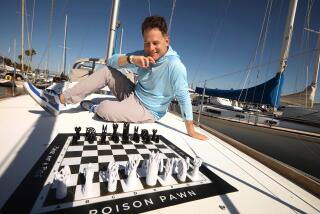O.C. Man Proves Himself Master of the Mind Game
- Share via
LAGUNA NIGUEL — Norm Haden met Jonathan P. Niednagel in 1985, when they were paired as first-year Little League coaches. Haden was a rookie, but he understood enough about the dynamics of Little League to know his new team would take its lumps.
When he and Niednagel prepared to select players, however, he got a really bad feeling.
“He’s walking around talking to these kids at the tryout and then he tells me he’s going to draft by ‘brain types,’ ” said Haden, a Los Angeles County firefighter who lives in Laguna Niguel. “I thought, ‘Oh, no, I’ve gotten hooked up with a real goofball.’ ”
Haden didn’t know it, but he had been teamed with a man on his way to becoming a Laguna Niguel youth coaching legend. Niednagel has coached more than 50 youth teams over the past decade and his ability to pick budding stars and unleash their hidden talents has blossomed into consulting jobs with major league baseball, the National Football League, National Basketball Assn. and National Collegiate Athletic Assn.
He does it with an uncanny ability to categorize personality types simply by watching movement and hearing nuances of speech. Niednagel is so good at it that he claims he can pick the sport a child will excel at after only a few seconds of observation.
His art is not witchcraft; sports and neuroscience experts ranging from UCLA basketball Coach Steve Lavin to Dr. Charles Ribak, a UC Irvine professor of anatomy and neurobiology, vouch for Niednagel.
Niednagel admits his theories are still not backed up by scientific research and anticipates the day they can be validated.
Within a few months, Haden had become a convert, a brain-typing believer. Their team won the division championship.
“The two best pitchers in the league were on [another] team, and everyone was conceding the championship to them,” Haden said. “But we just kept getting better and beat them out for the title. I was patting myself on the back for my coaching ability, but I realized I wasn’t as smart as I thought I was. It was John drafting by brain type.”
Niednagel first began to explore brain typing while managing a group of stockbrokers. He decided he could work more efficiently with them if he understood what made them tick.
Standard personality tests didn’t provide the insight he sought until he found one based on the works of Swiss psychologist and psychiatrist Carl Jung. Then he delved into Jung’s writings and discovered a knack for categorizing personality types by simply observing movement and nuances of speech.
Later, coaching a variety of youth teams as his children grew up, he realized that each personality type seemed to have particular athletic abilities and motor skills in common.
“I love sports, and so, you name it and I’ve coached it,” said Niednagel, who played basketball at Westmont College in Santa Barbara. “Working with hundreds and hundreds of kids, I started to realize I had this awareness of the inborn predisposition of kids. And once you know this, it’s easy to predict how a child will develop if you put them in the right environment.
“I would always draft [players] on brain types. The other coaches would think I was nuts because I would pick kids that were supposed to go much lower. I’d take a kid who couldn’t even catch the ball or hit it in the tryouts, but I knew that if I worked with him, by the end of the year he’d be far better than those other kids who were supposed to go higher.
“Individuals are like snowflakes, and upbringing and environment play significant roles in the formation of personality. But every person on the face of the globe falls into one of these 16 indelible, inborn, genetically predisposed cerebral designs. And it’s the single greatest determinant of why people do what they do.”
Niednagel says it’s simply a matter of the “way your brain is wired.”
This wiring is determined by four pairs of preferences: Introverted or Extroverted, Sensing or iNtuitive, Thinking or Feeling, Judging or Perceiving. Each person can be labeled with four letters, ISTJ for instance, if one happened to fall in the first category of each of the four pairs, as does Niednagel.
Once aware of which category a child falls into, it’s easy to point him to a particular sport or position where he might have a better chance to succeed.
Niednagel’s gift--he amuses himself by dropping the jaws of strangers on airplanes by accurately describing how they would react to certain situations--has led to more than rooms full of championship trophies for his children.
During the Phoenix Suns’ late-season drive to the playoffs this past season, Coach Danny Ainge said Niednagel’s advice was a key factor in the team’s resurgence.
Their relationship began seven years ago.
“A friend of mine who’s close to Danny had been talking to him about me, and Danny said, ‘If he’s so great, why don’t you have him tell you about the players and you tell me,’ ” Niednagel said.
As the second-hand information flowed, Ainge became intrigued and read Niednagel’s book, “Your Key to Sports Success.”
“When he was hired as an assistant at Phoenix, he hired me to help out with the draft,” Niednagel said, “and when he became the head coach, he started talking to me daily.”
Niednagel, who has worked with the NFL’s Washington Redskins and Kansas City Chiefs, just signed a three-year contract to work exclusively with the Suns and the Phoenix Diamondbacks expansion major league baseball team, which will reduce his time for pro football.
But he spent a week this spring watching more than 300 aspiring professional football players work out at the NFL scouting combine and classifying each into one of the 16 brain types, just by watching them walk and run.
Niednagel is currently involved in laboratory testing in an attempt to prove his theories about brain types and their connection with motor skills. He is providing blood samples of each of the 16 brain types to a University of California campus where attempts will be made to define genetic similarities.
“A recent National Institute of Health study showed that persons with certain kinds of genes were novelty-seekers and another group with a different genetic makeup were harm-avoiders,” Niednagel said. “Studies of twins raised apart support my theories as well.
“I started saying these things were inborn 15 years ago when it was believed that you were basically a product of your environment. But I’m a scientist, so it will be very exciting when all of my work is proven.”
Niednagel minored in science and has a bachelor’s degree in finance from Cal State Long Beach, where he transferred from Westmont.
Ribak is familiar with Niednagel’s theories and believes the technology exists to prove them now, without identifying every human gene.
“We have plenty of scientific evidence that some people use certain regions of the brain more than others,” Ribak said. “Unfortunately, most of the studies are done with people with various disorders, depressive illnesses or head injuries.
“I’d love to see a rigorous, definitive, brain-imaging study done on Jon’s hypothesis. I’ve certainly been impressed with the predictive nature of his theories. This could be a vital tool for guidance counselors.”
Brain typing might be helpful to general managers on draft day, possibly saving professional team owners millions by picking the right players, and it could aid parents in helping their children find sports in which they can excel. But UC Irvine’s Ribak is not the only one to suggest the benefits could extend to every segment of society.
An understanding of how you and those around you react to stress, change, suggestions, assignments, discipline, etc., could go a long way toward improved intrapersonal relationships.
Coto de Caza’s Vic Braden, long-time tennis guru and sports psychologist who collaborated with Niednagel on a video, is convinced the implications of Niednagel’s work are “gigantic.”
“If Jon is able to connect all this with empirical evidence, I’m convinced he’ll win the Nobel Prize,” Braden said “If someone can tell me what’s more important than this, I’d be very interested to hear it. Can you imagine sitting in the United Nations, knowing your adversary’s brain type and being able to change the way you listen, the way you negotiate, the way you make a request? And that’s just one example.
“I’ve been involved with sports psychology for a long time, and maybe the most important part of this revelation is that it allows people to feel more comfortable with our being different, knowing that there are genetic differences, and that just because someone doesn’t fit into a mold, it doesn’t mean they’re stupid or crazy.”
Psychometric questionnaires derived from Jungian typology are less than 75% accurate, but Niednagel doesn’t need test results to nail down your brain type.
By the time you’ve walked in and taken a seat on the couch in his office across from the pool at his Laguna Niguel home, he can rattle off your four letters and detail every weakness--and the few strengths--of your tennis game without ever seeing you swing a racquet.
Braden said he and Niednagel recently completed a study involving 104 subjects. Niednagel classified them all after only a brief conversation with each. After extended testing, Braden said there was only one case where he questioned Niednagel’s evaluation.
Niednagel’s on-the-spot classification skills have played a role on grander stages then Braden’s sports instruction academy or the fields of the Laguna Niguel Little League. Just ask Jim Harrick, who credits Niednagel with helping the Bruins win the men’s national basketball championship in 1995.
Lavin, then an assistant to Harrick, asked Niednagel to observe a Bruin practice session and offer his opinions.
“Steve told me, ‘Coach Harrick isn’t into gimmicks, but I’d like to hear what you have to say anyway,’ ” Niednagel said. “It was their third or fourth practice of the season and the players just ran up and down for a couple of hours.
“Afterward, Coach Harrick said, ‘OK, hotshot, you’ve got 15 minutes to tell me what you saw.’ ”
Three hours later, Harrick had decided Niednagel must be a psychic.
“I saved my evaluation of this one freshman for last,” Niednagel said. “I asked if they were planning on playing him much, and they said they didn’t figure he could help the team at all until his junior year. I had no idea who he was, but I knew he had the top type for basketball, same as Michael Jordan.
“When I told them they should give this kid a lot of minutes, Coach Harrick said, ‘Get out of here, you’re nuts.’ ”
By the time the Bruins were in the NCAA playoffs, Niednagel no longer had to campaign for the freshman to get playing time.
Toby Bailey was in the starting lineup and leading the Bruins to a national title.
More to Read
Go beyond the scoreboard
Get the latest on L.A.'s teams in the daily Sports Report newsletter.
You may occasionally receive promotional content from the Los Angeles Times.










